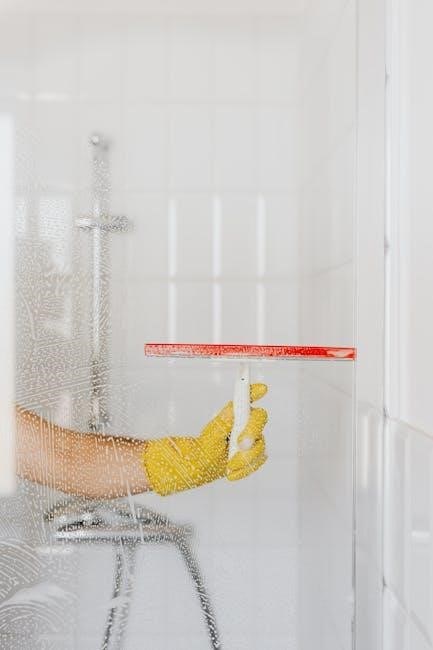Congratulations on purchasing the Bad Boy ZT Elite! This manual provides essential guidance for operating, maintaining, and troubleshooting your mower, ensuring optimal performance and longevity.
Overview of the Bad Boy ZT Elite Mower
The Bad Boy ZT Elite is a high-performance zero-turn mower designed for efficiency and durability. Featuring a powerful engine and advanced cutting technology, it offers precise control and a clean cut. Models like the ZT 4800 and ZT 6000 are equipped with Kohler engines, ensuring reliable operation. The mower boasts adjustable deck height, safety interlock systems, and a robust build. With a 382 cc Auto-Choke Engine and 6-Speed Manual Drive, it delivers excellent maneuverability. Compatible with various parts and accessories, the ZT Elite is ideal for both residential and commercial use, providing a versatile solution for lawn maintenance.
Purpose and Importance of the Manual
The purpose of this manual is to guide operators in maintaining and operating the Bad Boy ZT Elite mower effectively. It provides detailed instructions, safety guidelines, and troubleshooting tips to ensure optimal performance. By following the manual, users can extend the lifespan of their mower and prevent potential issues. The manual also serves as a reference for routine maintenance, parts identification, and proper usage of accessories. Whether for daily operation or complex repairs, this comprehensive resource is essential for maximizing the efficiency and longevity of the ZT Elite, ensuring it continues to deliver exceptional cutting results season after season.

Operating the Bad Boy ZT Elite
This section provides essential guidance on safely operating the ZT Elite, including pre-operation checks, control functions, and proper starting and stopping procedures for optimal performance.
Pre-Operation Checks and Safety Guidelines

Before operating the Bad Boy ZT Elite, perform a thorough pre-operation check to ensure safety and functionality. Always wear protective gear, including gloves and eyewear. Check oil and fuel levels, ensuring they meet the recommended specifications. Inspect tires for proper inflation and the mower deck for damage or obstruction. Verify that all safety interlock systems are functioning correctly. Clear the mowing area of debris and obstacles. Never allow children or pets near the mower while in operation. Consult the manual for specific instructions and adhere to all safety guidelines to prevent accidents and maintain optimal performance. Failure to follow these steps may result in equipment damage or personal injury. Always refer to the manual for detailed instructions. Proper preparation ensures a safe and efficient mowing experience. Stay alert and follow all manufacturer recommendations. Regular checks help extend the life of your mower. Safety is paramount, so never skip these critical steps. By following these guidelines, you can enjoy a trouble-free mowing experience with your Bad Boy ZT Elite. Always prioritize safety and proper maintenance for optimal results.
Controls and Features of the ZT Elite
The Bad Boy ZT Elite features intuitive controls designed for ease of operation and enhanced performance. The adjustable deck height allows for precise cutting, while the ergonomic design ensures comfort during extended use. The mower is equipped with a foot-operated hydrostatic transmission, enabling smooth speed control. Additional features include a safety interlock system to prevent accidental start-ups and a high-back seat for improved comfort. The deck lift system simplifies blade maintenance, and the zero-turn capability provides exceptional maneuverability. These features, combined with a robust engine, make the ZT Elite a powerful and user-friendly mowing solution for demanding lawn care tasks.
Starting and Stopping the Mower
To start the Bad Boy ZT Elite, ensure the parking brake is engaged and the mower is on a level surface. Check the surrounding area for obstacles or bystanders. Turn the ignition key to the “start” position and allow the engine to warm up briefly before moving. For stopping, slow the mower to a complete halt using the brake pedal and engage the parking brake. Turn the ignition off and ensure all controls are in neutral. Always follow proper shutdown procedures to avoid accidental starts and ensure safety. Regularly check the ignition system and brakes for optimal performance and reliability.
Maintenance and Care
Regular maintenance is crucial for the Bad Boy ZT Elite. Ensure proper lubrication, check oil levels, sharpen blades, and clean the deck. Always follow the recommended schedule and guidelines provided in the manual for optimal performance and longevity.
Recommended Maintenance Schedule
Regular maintenance is essential to ensure the Bad Boy ZT Elite operates efficiently and lasts for years. Follow the recommended schedule to maintain performance and prevent issues. Check the oil level daily before use, and change the oil every 100 hours of operation. Replace the air filter every 50 hours or as needed. Sharpen the mower blades monthly to maintain cutting quality. Inspect and clean the deck regularly to prevent debris buildup. Lubricate moving parts every 50 hours. Check tire pressure weekly and adjust as specified. Refer to the manual for detailed instructions and specific intervals tailored to your mower’s model and usage.
Oil and Fuel Requirements
The Bad Boy ZT Elite requires specific oil and fuel to ensure optimal performance. Use 10W-30 oil for all-weather conditions, and high-octane gasoline (87 octane or higher) for fuel. Regular oil changes are crucial; change the oil every 100 hours of operation to maintain engine health. Always check the oil level before starting the mower and top it off as needed. Use a high-quality fuel filter to prevent contaminants from entering the system. Avoid using old or stale fuel, as it can cause engine issues. Refer to the manual for exact specifications and recommendations tailored to your mower’s engine type and operating conditions.
Blade Maintenance and Replacement
Proper blade maintenance is essential for the Bad Boy ZT Elite’s performance. Inspect blades regularly for wear, damage, or dullness. Dull or damaged blades can tear grass, leaving uneven cuts. Sharpen blades when necessary using a grinder or file, ensuring they remain balanced. Replace blades immediately if they are bent or cracked. Use genuine Bad Boy replacement blades to maintain quality and safety. Always disconnect the spark plug before performing blade maintenance to prevent accidental start-ups. Follow the manual’s specific instructions for blade removal and installation to ensure safety and optimal mowing results. Regular blade upkeep enhances cutting efficiency and prolongs mower longevity.
Troubleshooting Common Issues
This section helps identify and resolve common problems with the Bad Boy ZT Elite, such as starting issues or uneven cuts, using diagnostic guides and solutions.
Diagnosing Problems
Diagnosing issues with the Bad Boy ZT Elite begins with identifying specific symptoms. Common problems include engine issues, uneven cutting, or difficulty starting. Always refer to the manual’s troubleshooting section for guidance.
Start by checking error codes or unusual sounds. Inspect the mower’s components, such as blades, belts, and filters, for wear or damage. Consult the manual’s diagnostic charts to match symptoms with potential causes.
If the issue persists, follow the recommended steps in the troubleshooting guide or contact a certified service technician. Regular maintenance and adherence to safety guidelines can often prevent or resolve common issues effectively.
Common Issues and Solutions
Common issues with the Bad Boy ZT Elite include uneven cutting, engine trouble, or difficulty starting. For uneven cutting, check blade sharpness and deck alignment. Dull blades or incorrect deck settings can cause poor results.
Engine issues may stem from low oil levels or clogged air filters. Regularly check and maintain these components as outlined in the manual. Starting problems could be due to a faulty spark plug or stale fuel. Replace the spark plug and ensure fresh fuel is used.
For persistent issues, consult the troubleshooting guide or contact a certified technician. Proper maintenance and adherence to guidelines can often resolve these problems effectively.

Parts and Accessories
The Bad Boy ZT Elite supports a range of parts and accessories, including replacement blades, belts, and filters. Accessories like mulch kits and bagger attachments enhance functionality.
Compatible Parts for the ZT Elite
The Bad Boy ZT Elite is designed to work seamlessly with a variety of compatible parts, ensuring optimal performance and longevity. These include oil filters, air filters, mower blades, and belts, all specifically engineered for the ZT Elite series. Parts like the Kohler engine oil filter (part number 12-050-01) and the heavy-duty mower blades (part number 030-6050-00) are essential for maintaining your mower’s efficiency. Additionally, accessories such as deck wheels and mulching kits are available to enhance functionality. Always refer to the official manual or manufacturer’s website for a comprehensive list of compatible parts to ensure proper fitment and performance.

Accessories for Enhanced Performance
To maximize the functionality of your Bad Boy ZT Elite, consider adding accessories designed to enhance performance and convenience. A mulch kit is ideal for evenly distributing grass clippings, while a striping kit creates professional-looking lawn patterns. Deck wheels and LED light kits are also available, improving maneuverability and visibility. Additionally, storage covers and hitch kits provide protection and versatility. These accessories are engineered specifically for the ZT Elite, ensuring compatibility and ease of installation. For a complete list of recommended accessories, refer to the official manual or visit the Bad Boy Mowers website to explore options tailored to your needs.
Congratulations on completing the Bad Boy ZT Elite manual! With proper operation and maintenance, your mower will deliver exceptional performance for years to come. Happy mowing!
Final Tips for Optimal Performance
For the best results with your Bad Boy ZT Elite, always follow the recommended maintenance schedule and use the specified 10W30 oil. Regularly inspect and clean the mower deck to ensure even cutting. Keep blades sharp and balanced for optimal performance. Refer to the manual for proper troubleshooting and adjustments. Adhere to safety guidelines to prevent accidents and prolong the life of your mower. Store the machine in a dry, protected area during off-seasons. By following these tips, you’ll maximize efficiency, maintain reliability, and enjoy years of superior mowing performance from your Bad Boy ZT Elite.












































